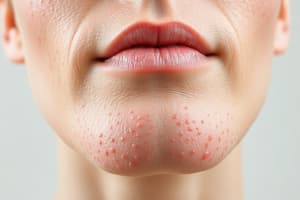Podcast
Questions and Answers
A patient presents with raindrop-size lesions. Which of the following preceding infections is most likely associated with this presentation?
A patient presents with raindrop-size lesions. Which of the following preceding infections is most likely associated with this presentation?
- Staphylococcus aureus skin infection
- Escherichia coli induced gastroenteritis
- Candida albicans infection
- Streptococcal throat infection (correct)
Where is generalized pustular psoriasis most likely to present?
Where is generalized pustular psoriasis most likely to present?
- Hands and feet
- Scalp and face
- Natal cleft and below the buttocks (correct)
- Elbows and knees
A patient is diagnosed with psoriasis. Which of the following mechanisms of action is shared by emollients, topical steroids and vitamin D analogues in the treatment of this condition?
A patient is diagnosed with psoriasis. Which of the following mechanisms of action is shared by emollients, topical steroids and vitamin D analogues in the treatment of this condition?
- Reducing the rate of skin production (correct)
- Increasing skin cell adhesion
- Promoting melanocyte proliferation
- Increasing inflammation
A patient presents with flat-topped, violaceous papules primarily on their wrists and lower back. Which condition do these symptoms most closely align with?
A patient presents with flat-topped, violaceous papules primarily on their wrists and lower back. Which condition do these symptoms most closely align with?
In which of the following locations is lichen planus most likely to cause scarring?
In which of the following locations is lichen planus most likely to cause scarring?
A patient presents with coin-shaped lesions on their legs. Based on the descriptions, which type of eczema is most likely?
A patient presents with coin-shaped lesions on their legs. Based on the descriptions, which type of eczema is most likely?
A patient with venous incompetence develops eczema around the affected area. Which type of eczema is most likely to be diagnosed?
A patient with venous incompetence develops eczema around the affected area. Which type of eczema is most likely to be diagnosed?
Which of the following is NOT a typical management strategy for eczema?
Which of the following is NOT a typical management strategy for eczema?
A patient with eczema develops yellow crusting and weeping lesions. Which secondary infection is most likely?
A patient with eczema develops yellow crusting and weeping lesions. Which secondary infection is most likely?
A patient with eczema is suspected of having a secondary herpes simplex infection (eczema herpeticum). Which treatment is most appropriate to initiate?
A patient with eczema is suspected of having a secondary herpes simplex infection (eczema herpeticum). Which treatment is most appropriate to initiate?
Which of the following is a key clinical feature of psoriasis vulgaris?
Which of the following is a key clinical feature of psoriasis vulgaris?
A patient presents with numerous small, drop-like lesions on their trunk and limbs, following a recent streptococcal throat infection. Which type of psoriasis is most likely?
A patient presents with numerous small, drop-like lesions on their trunk and limbs, following a recent streptococcal throat infection. Which type of psoriasis is most likely?
A patient with long-standing atopic eczema presents with thickened, excoriated plaques due to chronic scratching. This presentation is most consistent with which type of eczema?
A patient with long-standing atopic eczema presents with thickened, excoriated plaques due to chronic scratching. This presentation is most consistent with which type of eczema?
Flashcards
Atopic/Flexural Eczema
Atopic/Flexural Eczema
Eczema affecting skin folds like elbows and knees.
Guttate psoriasis
Guttate psoriasis
Small, droplet-shaped skin lesions often appearing after a streptococcal throat infection.
Varicose Eczema
Varicose Eczema
Eczema caused by poor vein function, leading to blood leakage and irritation.
Pustular psoriasis presentation
Pustular psoriasis presentation
Signup and view all the flashcards
Psoriasis treatments
Psoriasis treatments
Signup and view all the flashcards
Seborrhoeic Eczema
Seborrhoeic Eczema
Signup and view all the flashcards
Discoid Eczema
Discoid Eczema
Signup and view all the flashcards
Lichen planus appearance
Lichen planus appearance
Signup and view all the flashcards
Lichen Simplex
Lichen Simplex
Signup and view all the flashcards
Lichen planus scarring
Lichen planus scarring
Signup and view all the flashcards
Psoriasis Key Feature
Psoriasis Key Feature
Signup and view all the flashcards
Common Psoriasis Sites
Common Psoriasis Sites
Signup and view all the flashcards
Psoriasis Vulgaris
Psoriasis Vulgaris
Signup and view all the flashcards
Study Notes
- There are 5 types of eczema.
Atopic/Flexural Eczema
- This type affects flexural areas of the body.
Varicose Eczema
- This is a progression of atopic eczema.
- It is caused by venous incompetence, leading to blood leakage into the skin, resulting in irritation.
Seborrhoeic Eczema
- It is located in the center of the face and scalp
Discoid Eczema
- It manifests as coin-shaped lesions, typically on the legs.
Lichen Simplex Eczema
-
It results from scratching
-
Eczema can become secondarily infected in 4 ways.
Irritant Contact
- This can be caused by over-handwashing.
Allergic Contact Dermatitis
- This can be caused by make-up
Staphylococcus Aureus (Impetiginised Eczema)
- It is characterised by yellow crust and weeping.
Herpes Simplex (Eczema Herpeticum)
-
It is characterised by monomorphic lesions.
-
Eczema Management is done in 7 ways:
- Avoiding soap
- Using emollients such as soap substitutes and moisturisers
- Applying topical steroids
- Administering oral antibiotics
- Using antihistamines (sedatives)
- Applying wet wraps
- Administering acyclovir, if herpes simplex is suspected (eczema herpeticum)
-
A key clinical feature of psoriasis:
- Symmetrical, well-defined red plaques with a thick, silvery scale.
-
Common sites for psoriasis:
- Elbows
- Knees
- Back
-
There are 4 types of psoriasis:
- Vulgaris
- Guttate
- Erythrodermic
- Pustular
Psoriasis Vulgaris
- Consists of chronic plaque psoriasis.
- Presents as well-defined salmon pink plaques with silvery scales.
Guttate Psoriasis
- Presents as raindrop-size lesions.
- Often follows a streptococcal throat infection.
Generalised Pustular Psoriasis
-
Presents in the natal cleft and below the buttocks.
-
Psoriasis treatments (7) and branching purpose:
- Emollients/bath oils
- Vitamin D analogues (e.g., calcipotriol)
- Tar preparations
- Topical steroids
- Dithranol
- UVB, PUVA
- Systemic treatments: acitretin, methotrexate, cyclosporin, biologics
-
These treatments reduce the rate of skin production.
Lichen Planus
-
Appears as flat-topped violaceous papules on the skin.
-
Has a predilection for flexor surfaces (wrists) and the lower back.
-
There are 3 types of Lichen Planus:
- Papular
- Hypertrophic
- Macular + pigmented
-
Lichen planus can cause scarring on the scalp and fingernails.
Studying That Suits You
Use AI to generate personalized quizzes and flashcards to suit your learning preferences.
Description
Eczema manifests in various forms, each with distinct characteristics and triggers. Secondary infections can arise from irritant or allergic contact, bacterial agents like Staphylococcus aureus, or viral agents such as Herpes Simplex. Effective management involves gentle skincare, emollients, and topical treatments.




